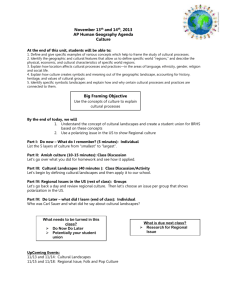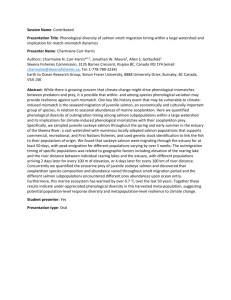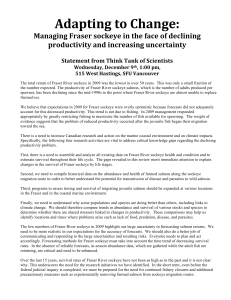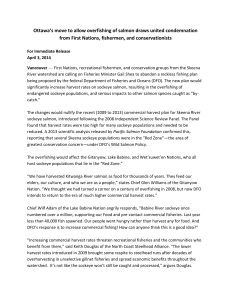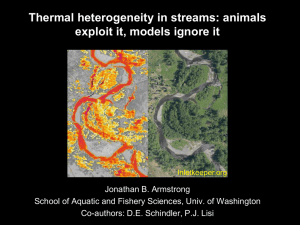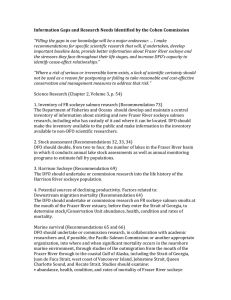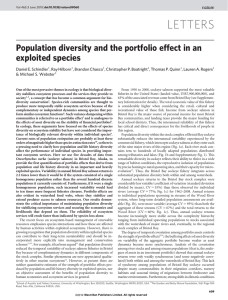Published figures arising out of FISH554
advertisement
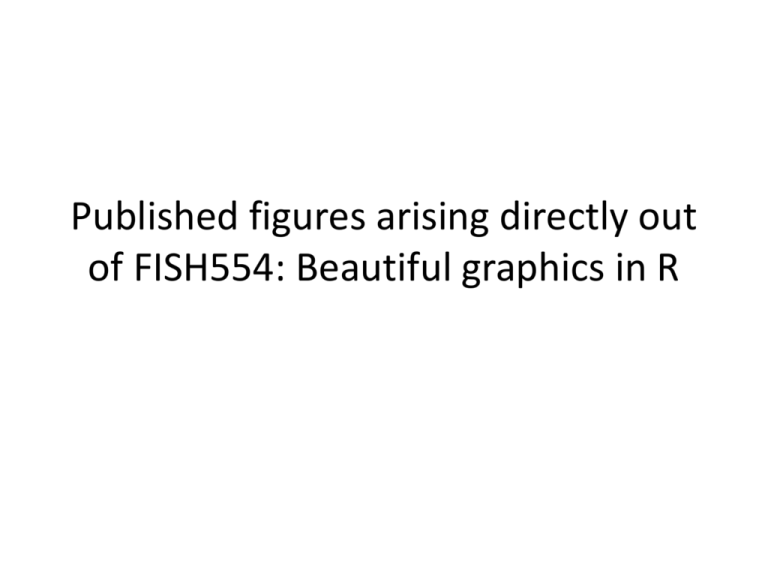
Published figures arising directly out of FISH554: Beautiful graphics in R Figure 4. (a) Contour plot of LSD (linear selection differential) values, the product of different exploitation rates and length selectivity values (the difference in the average length of fish caught vs. those not caught), of a fishery. LSD values are the difference in length of fish before fishing vs. after fishing (not caught). Actual (b) female and (c) male annual exploitation rates and length selectivity values, along with the resulting LSDs, produced in a total of 283 years by the nine Alaskan sockeye salmon fisheries examined in our study. The grayscale legend refers to these LSD values produced. Background contour lines in panels (b) and (c) show where the product of a fishery’s exploitation rate and lengthselectivity value equals a given LSD value. Created by Neala Kendall as part of the 2011 course. Kendall, N. W. and T. P. Quinn. 2012. Quantifying and comparing size selectivity among Alaskan sockeye salmon fisheries. Ecological Applications 22:804-816. Figure 3 Directional differences between (a) free-flowing and flow-regulated rivers for per cent opportunistic and equilibrium life history strategies and (b) a principal components ordination summarising variation among rivers according to the six major flow metrics. Dam types are coded by line type where solid lines indicate hydropower, dashed lines indicate flood control, and dotted lines indicate locks. Sites are labelled at the base of each arrow, and labels correspond to Fig. 1. Created by student Meryl Mims as part of the 2011 course. Mims MC, and Olden JD (2013) Fish assemblages respond to altered flow regimes via ecological filtering of life history strategies. Freshwater Biology 58:50-62. doi: 10.1111/fwb.12037 Figure 4 Pairwise per cent differences of (a) opportunistic, (b) periodic and (c) equilibrium proportional life history strategies and (d) % nonnative species versus the Flow Alteration Index. Symbols indicate dam type, and symbol fill indicates release type. Created by student Meryl Mims as part of the 2011 course. Mims MC, and Olden JD (2013) Fish assemblages respond to altered flow regimes via ecological filtering of life history strategies. Freshwater Biology 58:50-62. doi: 10.1111/fwb.12037 Figure 1. (a) Map of Wood River basin showing sockeye salmon spawning locations and corresponding average summer water temperature as indicated by dot colour. (b) Relationship between water temperature and sockeye salmon spawning date. (c,d) Cumulative distribution functions (cdf), representing the proportion of the cumulative seasonal activity observed at any site on a specific date, for (c) gulls and (d ) bears at sockeye salmon spawning locations. Colours of lines correspond to water temperatures, and insets show relationship between the mean of the cdf for gulls and bears, and sockeye salmon spawn timing among study sites (see the electronic supplementary material, table S1). Created by student Peter Lisi as part of the 2011 course. Schindler DE et al. 2013. Rising the crimson tide: mobile terrestrial consumers track phenological variation in spawning of an anadromous fish. Biology Letters 9:20130048. doi: 10.1098/rsbl.2013.0048 Figure 6. This figure shows how hole proportion can lower the degree mean of forest landscapes. Loesssmoothed degree means (d) from 20 000 simulations are plotted in the top graph with sample landscapes below. The order of the lines in the top graph, from top to bottom, is uniform, cluster, SSI, and lattice. This ordering is consistent throughout the domain, with landscapes generated using the lattice method having noticeably lower degree means than landscapes generated from other point processes. This example uses landscapes generated using each point process exclusively to highlight the differences between them. In practice, landscapes will generally use a mixture of point processes. The shaded filled polygons indicate management units that have been deleted during the editing process. Created by Gregor Passolt as part of the 2011 course. Passolt, G. et al. 2013. A Voronoi tessellation-based approach to generate hypothetical forest landscapes. Canadian Journal of Forest Research. 43:78-89. doi: 10.1139/cjfr-2012-0265

